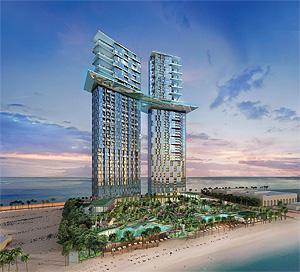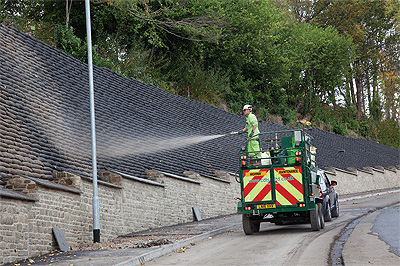Complete Transformations: Gilbert-Ash Redefines Urban Spaces with Arnold House Redevelopment
Modern transformation
Gilbert-Ash has completed the redevelopment of Arnold House in the fast-growing ‘Tech-City’ area of London. Working closely with Buckley Gray Yeoman architects, the Gilbert-Ash team totally transformed the seven-storey building – the £15m project included a three-story extension, and an inverted roof with decking that has created terrace spaces, with tenants able to enjoy views of the Shoreditch streetscape.
Gerard Mullan, Gilbert-Ash Project Manager, explained that the final internal and external Arnold House refurbishment works well in the surrounding modern Tech-City environment. “The contemporary space has been carefully constructed to keep the industrial style of the building but with additional features you would expect in a productive, collaborative space. From the ground floor to the roof terrace and landscaped courtyard, we aimed to create a space that would meet the needs of today’s modern, flexible workforce. The building includes office space with retail units on the ground floor in a fantastic location, right in the heart of Tech City.”
Located on the corner of Great Eastern Street and Holywell Lane, the new development is a BREAMM Very Good building with a WiredScore Gold certification.
Work continues in Dubai
 Bauer Spezialtiefbau GmbH’s subsidiary in Dubai had already played a key role in the construction of Dubai’s artificially built island of Palm Jumeirah, and at the beginning of October 2018, the first contracts for the new PALM360 project on Palm Jumeirah were awarded by the developer Nakheel during the Expo Real trade show in Munich. Over the course of this, Bauer Spezialtiefbau was commissioned with the specialist foundation engineering works for a new luxurious hotel and residential project.
Bauer Spezialtiefbau GmbH’s subsidiary in Dubai had already played a key role in the construction of Dubai’s artificially built island of Palm Jumeirah, and at the beginning of October 2018, the first contracts for the new PALM360 project on Palm Jumeirah were awarded by the developer Nakheel during the Expo Real trade show in Munich. Over the course of this, Bauer Spezialtiefbau was commissioned with the specialist foundation engineering works for a new luxurious hotel and residential project.
The project, estimated at around 5.6 million euros, includes the implementation of around 600 foundation piles to a depth of 54m to stabilise the ground for the construction of the 260m long building, the future tallest building, on Palm Jumeirah. The project consists of the construction of the luxury hotel ‘Raffles The Palm Dubai Hotel’ as well as the residential development ‘Raffles Residences PALM360’. Once completed, the complex will have the world’s largest sky pool which will connect the two building towers at a height of 170 m. There are also numerous restaurants, wellness facilities and a 500,000 m² landscape garden with various luxury and leisure offers planned.
New waste process
In a construction boom, raw materials and supplies are being placed under increasing supply pressure, while the environmental damage wrought by the leftovers of construction work is growing.
Germany’s Fraunhofer institute has worked on a compromise solution to both these problems, in the form of a €3.3m research project over the past three years. The project has yielded promising results: In addition to aerated concrete from building rubble there are also acoustic building materials and components made of mineral granules. The full findings will be presented at the BAU 2019 trade fair in Munich, held from January 14-19.
One of the key aspects of the research was to do something constructive with the around five million metric tons of fine-grained building rubble left behind during construction work in Germany each year. Hitherto this material has often ended up in landfills or roads, but the Fraunhofer Institutes for Building Physics IBP, for Material Flow and Logistics IML, for Environmental, Safety and Energy Technology UMSICHT, and for Optronics, Systems Technology and Image Analysis IOSB together have come up with the BauCycle process, which upcycles the waste into high-quality building materials.
The process has the ultimate aim of transforming the mix of minerals within construction waste into a sustainable resource and demonstrate potential applications in construction, while there is also a target of setting up a dynamic market platform where the raw materials are traded as commodities.
New heights
The Berkeley Group’s South Quay Plaza development in London’s Docklands, one of the tallest residential towers in the UK and the tallest tower in the Berkeley Group, is set to use Veolia’s latest combined heat and power (CHP) technology to provide low carbon energy. Designed to deliver the energy needs of 888 new homes, spread across two new landmark residential buildings of 68 and 36 storeys, this latest CHP application will cut carbon emissions by 556 tonnes per year and help to meet London’s emission targets. In addition to providing the energy needs of residents, the CHP units will also supply energy to additional facilities including a swimming pool, spa, and gym.
Commenting on the project in London, Damian Shevloff, Managing Director, Veolia CHP UK said: “Veolia is now delivering the essential low carbon power to support new communities and boosting the energy efficiency of buildings, both of which are key to establishing the sustainable cities of the future. By using our latest energy efficiency services and integrating the leading technologies we can not only power modern living but also make a real contribution towards meeting London’s environmental targets. As 15one of the biggest cities in the world it is important for London to set an example and this shows what can be achieved.”
Sowing the seeds
 Seven million seeds have been sprayed onto 6000 bags of soil and nutrients as part of an ambitious scheme by Calderdale Council and West Yorkshire Combined Authority to tackle congestion along the A629. The new living wall will improve local air quality by absorbing carbon dioxide and nitrogen dioxide as well as delivering biodiversity benefits for the area and enhance the overall surroundings.
Seven million seeds have been sprayed onto 6000 bags of soil and nutrients as part of an ambitious scheme by Calderdale Council and West Yorkshire Combined Authority to tackle congestion along the A629. The new living wall will improve local air quality by absorbing carbon dioxide and nitrogen dioxide as well as delivering biodiversity benefits for the area and enhance the overall surroundings.
Divided into five phases, the A629 scheme will help reduce congestion, improve journey times, boost public transport use and improve cycling and walking conditions along the key route between the towns of Halifax, in Calderdale, and Huddersfield, in Kirklees. In Calderdale, the scheme will also deliver improvements in Halifax town centre, including bus and rail interchange opportunities, an improved bus station, new bus routing and improved quality public areas. The scheme is being supported by £120 million investment from the Combined Authority’s £1 billion West Yorkshire-plus Transport Fund.